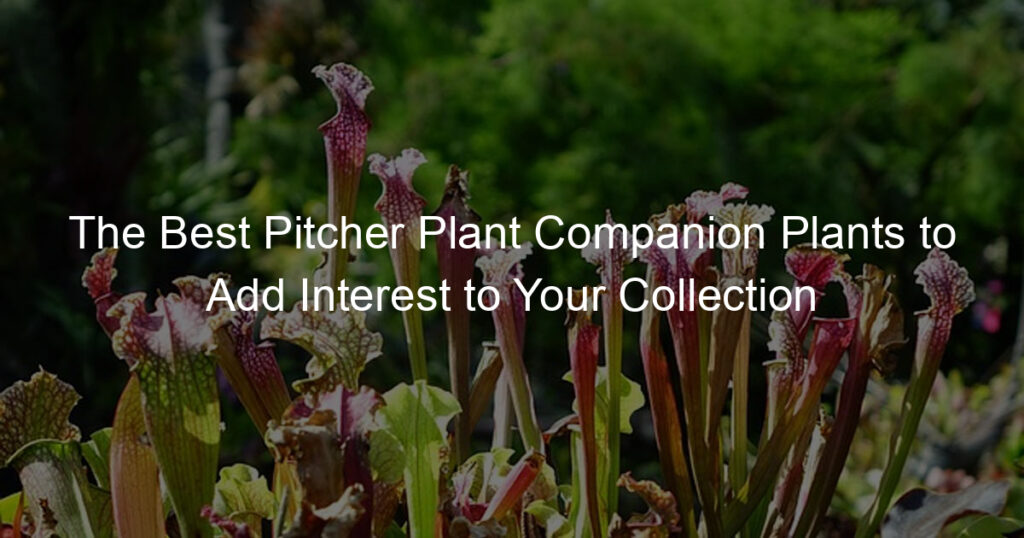Do you love pitcher plants and want to add some variety to your collection? Adding companion plants is the perfect way to make your display more interesting, diversify pests, and spice up its overall look. With a little knowledge and creativity, you can create a beautiful environment for your pitcher plant that helps it thrive while adding visual interest along the way.
What are pitcher plant companion plants?
Pitcher plants are fascinating wetland carnivorous plants that capture and digest insects as a source of nutrients. Their overall structure is rather complex, often making them even more interesting and unique.
Of course, with each different species comes a whole new range of potential companion plants, which can enhance the beauty of the pitcher plant. Many common examples of pitcher plant companion plants include various ferns and mosses, plus grass-like sedges and rushes.
These further add to the wetlands environment where the pitcher plant was found growing indigenous in the first place. With such an array of possible choices for companion plants, pitcher plants make for an exciting addition to anyone’s garden – adding beauty and uniqueness at the same time!
What are some good companion plants for pitcher plants?
When planning which plants to grow alongside your pitcher plants, there are many great choices. For ground cover, colorful carpeting of creeping thyme or shorter sedges and grasses will look beautiful around the pitchers.
Sun-loving oxalis and golden club Moss are also good additions that thrive when grown together with pitcher plants in damp and acidic soil. Creeping Phlox provides a snap of color as well as low-maintenance foliage. Carnivorous sundews will also pair well with a pitcher plant garden and provide an interesting contrast in form and flower.
Overall, selecting companion plants for your pitcher plant will not only provide them with an attractive backdrop but can also help to create and maintain the correct environment for successful growth.
How do companion plants benefit pitcher plants?
Pitcher plants are an interesting species of flower with an appetite quite unlike other plants. They are carnivorous and utilize insects to gain essential nutrients that they would otherwise miss out on.
This is where companion plants come in; they provide an attractive environment for the pitcher plant’s prey, usually, ants or flies, which ensures that there is always a readily available food source right at the doorstep.
Companion plants can also help give the flower more exposure to sunlight than it may typically receive as well as feed it some important minerals that regular soil does not contain. By choosing the perfect companions, even a pitcher plant can have a thriving garden life!
Can you plant other carnivorous plants with pitcher plants?
If you’re looking to diversify your carnivorous plant collection, planting other varieties alongside your pitcher plants is certainly possible. Carnivorous plants generally need to be planted in soil that has been acidic, wet, and low in nutrients to maintain their ability to capture prey.
Luckily pitcher plants enjoy the same kind of conditions, so getting other types of carnivores involved will not require major adjustments to the environment.
Sundews, butterworts, and bladderworts can be grown with pitcher plants for a unique collection that is sure to draw attention from any visitors you may have. With proper care and attention, you could soon find yourself with a truly voracious garden!
What are some plants to avoid planting with pitcher plants?
When it comes to pitcher plants, some plants are best kept away from them. Anyone attempting to create a pitcher plant garden should avoid nearby planting of species sorted in the Apiaceae family such as carrots, parsnips, and parsley since their roots can interfere with the neighbor’s root systems.
You should also refrain from planting herbs and spices such as fennel and dill since they share similar nutritional requirements as a carnivorous plants.
Instead, choose complimentary perennials that need ample sunlight and moist soil like Asteraceae, Primulaceae, or Poaceae families. Ferns are great too because they have a shallow root system which helps prevent competition for apex growth!
How do you care for pitcher plant companion plants?
When gardening with pitcher plant companion plants, it is important to practice attentive and careful garden care. Keep the soil moist, not wet, provide plenty of sunlight, and fertilize regularly.
When maintenance is kept up properly, these companion plants can not only create a unique addition to any garden but will also keep the pitcher plant healthy and vibrant.
With proper pruning, appropriate soil amendments, an eye on water levels, and fertilizer applications these stunning companion plants can happily coexist with their carnivorous partner.
Conclusion
All in all, if you’re looking to add visual interest to your pitcher plant collection, a few strategically placed companion plants can turn heads! Whether it’s Spanish moss cascading around your collection or some colorful violets artfully arranged nearby – the options are truly endless.








